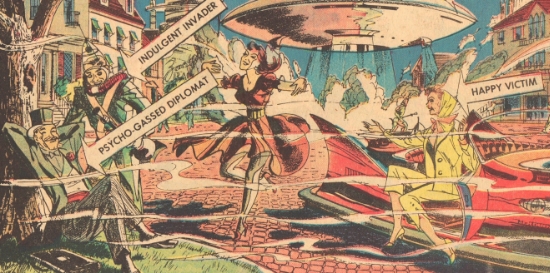Tripping Through the Cold War: Drug Warfare in the Retrofuture
Was LSD the Soviet Union’s secret weapon?
/https://tf-cmsv2-smithsonianmag-media.s3.amazonaws.com/filer/LSD-dino_header.jpg)
Chemical warfare is nothing new. As early as 428 BC the Spartans were burning wood soaked in resin and sulfur for use against their enemies. And the First World War is often remembered for its horrific deaths due to mustard gas. But the mid-20th century ushered in a new futuristic chemical weapon: LSD.
Lysergic acid diethylamide (LSD), mescaline (peyote), and psilocybin (psychedelic mushrooms) were all seen as possible contenders for non-lethal weapons of the future; sprayed on an unsuspecting army or civilian population and making them vulnerable to invasion.
An Associated Press story from the September 6, 1959 Cedar Rapids Gazette in Iowa warned that the nuclear stalemate with the Soviet Union might prompt the Russians to develop chemicals that could be used against the United States. Americans scientists were said to have developed their own weapons to counter-attack.
Working in deep secrecy, U.S. scientists almost overnight have developed an arsenal of fantastic new weapons, variously known as psycho-chemicals and “madness” gases, which could virtually paralyze an enemy nation without firing a shot.
Interestingly, the article doesn’t name the chemicals, instead calling them “madness gases” or surgical anesthetics:
By way of definition, chemical warfare embraces the use of such compounds as the psycho-chemicals to create hallucinations in the enemy’s mind or the deadly nerve gases and other toxic substances to kill.
Some of the new chemicals act much faster than ether, the anesthetic used to put surgical patients to sleep, and have an effect lasting 24 to 48 hours. One means of dispersal is a newly developed “smoke ginny” with which 2 men can lay a blanket of chemical fog over an area 5 miles long and 200 yards wide.
The February 28, 1960 edition of the Sunday comic strip “Closer Than We Think” by Arthur Radebaugh pulled this idea from the headlines and illustrated it in the picture above. The strip quotes Lt. Gen Arthur Trudeau from the U.S. Army as warning that the Soviets are developing weaponized versions of “psycho-chemicals” and that the U.S. should follow suit:
New nerve drugs may be used to immobilize whole cities or battle areas in tomorrow’s warfare. The Chemical Corps knows about a complete arsenal of “nerve gases” that can make fighting men and embattled citizenry as happy and peaceable as kids playing tag.
Lt. Gen. Arthur Trudeau, chief of Army research and development, is worried about possible attacks with these drugs. He fears the United States might become a victim. “The Soviet has 15% of its munitions in chemicals,” he said. “I think psycho-chemicals are the coming weapon — we are missing out if we don’t capitalize on them.”

People tripping out in the February 28, 1960 edition of Closer Than We Think
The 1981 children’s book World of Tomorrow: War and Weapons by Neil Ardley also illustrated what a psycho-chemical attack might look like, with soldiers believing they’re being hunted by giant flying pterodactyl-like creatures:
This isn’t a scene from a science fiction story in which flying monsters take over the world. It is a view of a future battle as seen through the eyes of a defending soldier. He and his fellow troops reel back as invading aircraft fire shells containing chemicals. The chemicals are drugs that produce dream-like reactions or hallucinations in people. The soldiers see the aircraft turning into flying monsters and the buildings bend over, and they flee in terror. Invading forces protected from the effects of the drugs will soon arrive easily take over the city.
/https://tf-cmsv2-smithsonianmag-media.s3.amazonaws.com/accounts/headshot/matt-novak-240.jpg)
/https://tf-cmsv2-smithsonianmag-media.s3.amazonaws.com/accounts/headshot/matt-novak-240.jpg)